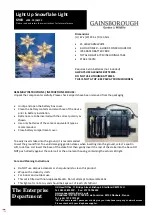
SKU 92699
For technical questions, please call 1-800-444-3353
Page 3
9.
Maintain tools with care. Keep tools sharp and clean for better and safer
performance. Follow instructions for lubricating and changing accessories.
Inspect tool cords periodically and, if damaged, have them repaired by an
authorized technician. The handles must be kept clean, dry, and free from oil
and grease at all times.
10. Remove adjusting keys and wrenches. Check that keys and adjusting
wrenches are removed from the tool or engine work surface before operating.
11. Stay alert. Watch what you are doing, use common sense. Do not operate
any tool when you are tired.
12. Check for damaged parts. Before using any tool, any part that appears
damaged should be carefully checked to determine that it will operate
properly and perform its intended function. Check for alignment and binding
of moving parts; any broken parts or mounting fixtures; and any other
condition that may affect proper operation. Any part that is damaged should
be properly repaired or replaced by a qualified technician.
13. Replacement parts and accessories. When servicing, use only identical
replacement parts. Use of any other parts will void the warranty. Only use
accessories intended for use with this tool. Approved accessories are
available from Harbor Freight Tools.
14. Do not operate tool if under the influence of alcohol or drugs. Read
warning labels if taking prescription medicine to determine if your judgment or
reflexes are impaired while taking drugs. If there is any doubt, do not operate
the tool.
15. Avoid working alone. If an accident happens, an assistant can bring help.
Additional Product Specific Safety Precautions
1.
Do not use Fuel Injection Test Kit on diesel engines.
2.
Loosen gas cap and relieve fuel pump pressure before testing.
3.
Before testing fuel system, verify all connections are tight to eliminate
leaking.
4.
Do not change fittings with engine running.
5.
Gasoline is highly flammable. Do not smoke, or test near open flames or a
source of electrical sparks.
6.
Do not allow gasoline to come in contact with the hot manifolds or other
engine components.
7.
Do not drive the vehicle while under test.
8.
If portable lighting is required, use only explosion proof drop-light.

























